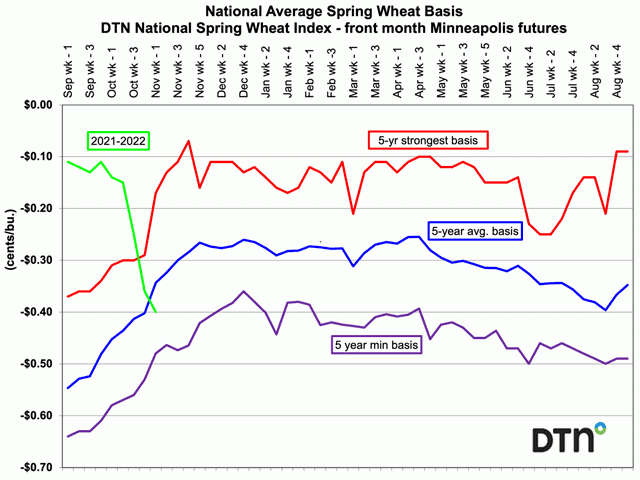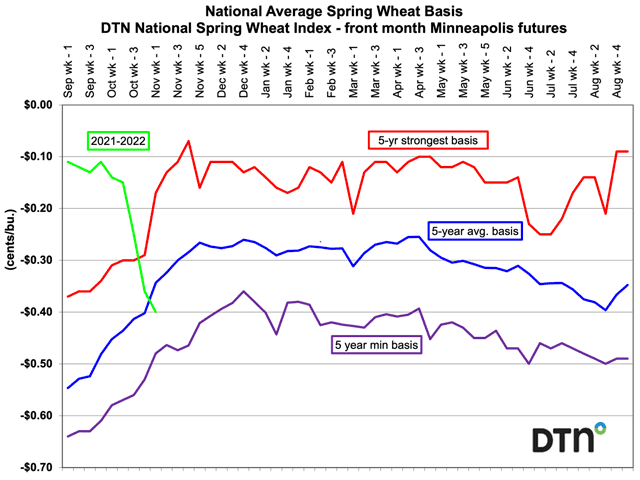Market Matters Blog
What Happened to Spring Wheat Basis?
After spring wheat rang in the new-crop year starting on Sep. 1, 2021, the futures have been on a steady climb, making contract highs on their way higher. Since that day and through the close on Nov. 5, December Minneapolis spring wheat futures have gained $1.10 3/4. That hefty gain is even after the futures dropped 43 cents during the week ended Nov. 5.
Meanwhile, basis has been dropping like a rock, which in my experience is a typical move for spring wheat when the flat price has gained substantially like it has since Sep. 1. Spring Wheat Trading 101 teaches that the market marches to the beat of a different drummer and very rarely makes sense to those who are not familiar with it; sometimes, not even to those who trade it.
The severe drought in North Dakota and Montana deeply cut production in those states and, according to the USDA Small Grains Summary released Sep. 30, other spring wheat production was at 331 million bushels (mb), down 44% from 2020; durum wheat production was at 37.3 mb, down 46% from 2020. The October USDA ERS Wheat Outlook said hard red spring (HRS) production was lowered 8 mb, to 297 mb, as reduced area harvested more than offset the impact of a higher yield. The harvested-to-planted ratio for HRS is estimated at 89%, which is much smaller than usual as drought conditions resulted in historically large abandonment for this class, the report noted.
We still aren't 100% sure just how many HRS planted acres were hayed for livestock feed and that won't be known until the final "Other Hay" estimates reported in the Annual Crops Summary published in January 2022, according to Darin Jantzi from the North Dakota NASS Field Office.
The wheat outlook report also noted that 2021/22 all-wheat export forecast is unchanged at 875 mb, but there are offsetting changes to individual classes. HRW exports were raised 5 mb, to 360 mb, based on a strong pace of export sales and tight competitor supplies. On the other hand, white wheat exports were reduced 5 mb, to 155 mb, based on a weak pace of export sales and historically tight supplies. One Pacific Northwest (PNW) exporter thinks total spring wheat exports off the PNW this crop year could be 160 mb versus 220 mb of exports there in the prior crop year. However, given the current flat price, he noted that U.S. spring wheat has become too expensive for Asian buyers, and that it is even hard to sell it to U.S. buyers. Given the high protein in this year's crop, thanks to the drought, it allows more cheaper winter wheat to go into a miller's grind.
P[L1] D[0x0] M[300x250] OOP[F] ADUNIT[] T[]
While U.S. Wheat Associates reported a sound 2021 spring wheat crop grading U.S. No. 1 Dark Northern Spring (DNS) overall on average, with a test weight of 61.3 pounds on average (slightly lower than the 2020 and five-year averages), the protein of 15.4% (thanks to the drought) was high and well above 2021 and the five-year average. That means the 2021 crop needs to be blended down to 14% to meet the specifications wanted by importers and mills. That also means any available 13% to 14% protein spring wheat and/or 12% to 13% hard red winter wheat could cost buyers more. Flour mills prefer 12% protein when it comes to making flour. While flour mills make a 13% protein flour, the most common is a mid-mix, 12% protein flour. It is interesting to note that 1% of the wheat protein is lost in the flour-making process.
If you look at the current elevator spring wheat prices across North Dakota on Nov. 5, they were still bid above $9 a bushel, a very good price for farmers who didn't suffer from drought-related losses and have wheat left to sell. However, there are those of us former and current spring wheat traders, as well as farmers, who were around in mid-February 2008 when front-month Minneapolis spring wheat futures hit $19.80 a bushel. Everything you thought you knew about the spring wheat market didn't apply and it made for some crazy high flat prices offered to farmers.
The cash price during that time at many grain elevators rose from $16 to $20 per bushel as supplies were tight and demand was high. As prices climbed steadily before hitting those highs, farmers started to sell some of their supplies. Once the $20 per bushel hit, farmers with any wheat left "locked the bin." You can be sure 2008 is currently on the minds of some farmers given that the 2021 spring wheat crop supply is low.
I placed a poll on Twitter this past week and gave spring wheat farmers three choices to answer if they had anything left to sell at the current high flat price. Here are the results:
-- Sold it all: 19.8%
-- Have "some" left: 48.8%
-- Locking the bin: 31.4%
If the flat price keeps moving higher, what will happen to the basis going forward? If you know what the spring wheat futures will do, you may have the answer or you may not. One thing that is certain is we won't have a new supply of spring wheat for at least 10 months.
As the saying goes, "buckle up," which in the figurative sense is a warning that something exciting, frightening or otherwise intense is about to happen and that certainly fits the spring wheat market.
Mary Kennedy can be reached at mary.kennedy@dtn.com
Follow her on Twitter @MaryCKenn
(c) Copyright 2021 DTN, LLC. All rights reserved.






Comments
To comment, please Log In or Join our Community .